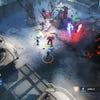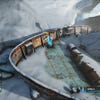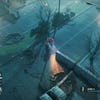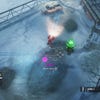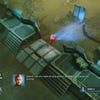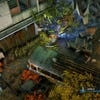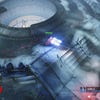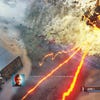Digital Foundry vs Alienation
A visual effects showcase, but is it a worthy successor to the brilliant Resogun?
Housemarque specialises in creating arcade action titles, with Alienation the latest in a long line of frenetic shooters backed up by a remarkable suite of technology. Conceptually, it's similar in nature to the firm's PS3/PS4 title, Dead Nation, but the sci-fi focus opens the door to a new gameplay focus, along with a radical revamp in visual effects work.
However, just like Dead Nation, the push for state-of-the-art visuals comes with a compromise. Alienation run at 30 frames per second, and not the signature 60fps that helped to make Super Stardust HD and Resogun feel so good to play. The knock on effect is that motion isn't quite as smooth as we would like, while the controls lack the crisp response found in arcade titles. However, by targeting 30fps, Housemarque has double the rendering time per frame to play with - the result being some impressive effects work that adds a new layer of realism to the game's arcade roots.
As expected the game runs at native 1080p with post-process anti-aliasing, presenting the action with ample clarity. Sub-pixel elements and long edges sometimes exhibit artefacts, but nothing beyond the kind of shimmering that is now part and parcel of most triple-A titles. However, what really stands out is the way in which characters and environmental objects are displayed. A physically-based rendering set-up allows for different surfaces to react realistically to various lighting conditions, so materials such as metals, snow, rubber and glass appear quite natural despite the game's stylised presentation. This adds a more authentic look to these elements, helping to better immerse the player in the locations on offer.
There's an eeriness in exploring the inhospitable snow covered outposts in Alaska during the opening missions, while the dark metallic corridors of the alien spaceships feature a nice degree of ambience despite the upbeat soundtrack and chaotic shooting. The use of volumetric lighting also adds to this atmosphere: snow, dust, and particles react to surrounding light sources, creating a warm glow around torches lamps and spotlights dotted across the environment, especially in icy blizzard conditions. However, when the action heats up, lighting serves a very different purpose: to create spectacle - enhancing the hectic firefights against hordes of alien invaders. Weapons fire casts light sources across the environment, creating quick flashes that make shootouts more exciting, while the light emitted by characters' torches interacts with environmental lighting, creating new shadows while also displacing existing ones.
As an arcade shooter you're constantly blowing up more than just the rampaging alien hordes: buildings and abandoned vehicles are all fair game here, with the resulting pyrotechnics taking out waves of enemies - a great tactical fallback when you're heavily under siege. Environmental destruction enhances the core gameplay on offer, with physics-based properties dictating how the bricks crumble and interact with characters and weapons fire. It's a nice touch, again adding realism to the experience. Of course, only some of the scenery can be blasted to pieces during shootouts, and aside from taking out a few enemies in the process this aspect mainly serves as eye-candy, as opposed to a fundamental gameplay device.
The use of physics also makes its way into the game's wind and particle systems, where these elements interact with both static and dynamic objects. For example, gusts of snow carve out a path around cars and buildings, while energy beam type weapons cut through these particles, pushing them in a different direction than the prevailing wind. Water is given similar properties too, with characters and other objects disrupting the surface, causing ripples to move through puddles on the ground.
Housemarque's attention to detail is really impressive when you consider that many of these elements have little impact on the core gameplay. Destruction aside, the bulk of the developer's advanced visual features are mainly geared towards generating extra atmosphere and helping to somewhat ground the fantastical alien invasion setting. But it's a feast for the eyes and it's cool to see realism brought into an arcade shooter: it adds more graphical flair to the action, especially when there are multiple players on-screen blasting away at dozens of enemies.
Detail levels also appear high across characters, though environmental objects are somewhat mixed in this respect. For example, cars that can be blown up look simpler than some of the non-interactive elements, such as ground ridden ships stuck in the snow. But at the same time, this helps to keep scenes from appearing cluttered, which benefits the action focus of the game.
On the whole, it's clear that Alienation is pushing a lot of interesting tech behind the scenes in order to make the gameplay look more exciting, and as a result a 60fps update is completely off the cards for this reason. It's a shame in some respects, as this means that the gameplay doesn't feel quite as crisp or responsive as Resogun or Super Stardust HD. The 30fps update never quite delivers the same level of controller feedback or motion smoothness as one would expect from a fast-paced arcade game. Movement feels rather weighty, and it takes a while to adjust to the reduced controller response. Motion handling also suffers to a degree, with camera pans throwing up judder on screen as you move across the environment - as it does in all 30fps titles.
It's a question of acclimatisation then - getting used to the action as it is presented. Aiming is still pretty sharp, and we had no trouble in blasting away waves of aliens from multiple directions. However, the gameplay comes across as less refined compared to similar titles operating at double the frame-rate. The good news is that performance is almost completely locked at 30fps though, meaning that the experience remains consistent throughout. An occasional dropped frame is the only blemish to appear, and the impact is nonexistent.
In an ideal world we've love to be playing Alienation at 60fps, but this simply isn't possible on standard PS4 hardware, where high frame-rates are traded in favour of extra graphical features. PlayStation Neo, though, now that's a different story. And with double the GPU power available that should make playing at much higher frame-rates a real possibility. Of course, there's no guarantee that Housemarque will produce a forward compatibility patch, but it would be great for Neo support to be patched in at a later date, unshackling a great game from its only real drawback.
But for now Alienation is an enjoyable arcade-style shooter on PS4, backed up by some impressive effects work that helps to enhance the visuals, making the game more satisfying to experience. Four player online co-op is a particular highlight, with sparks flying and destruction raining down across the environments as waves of enemies are gunned down. In that respect, Alienation delivers moments of spectacle confidently, and it's another highly accomplished addition to Housemarque's superb catalogue of PlayStation software.


